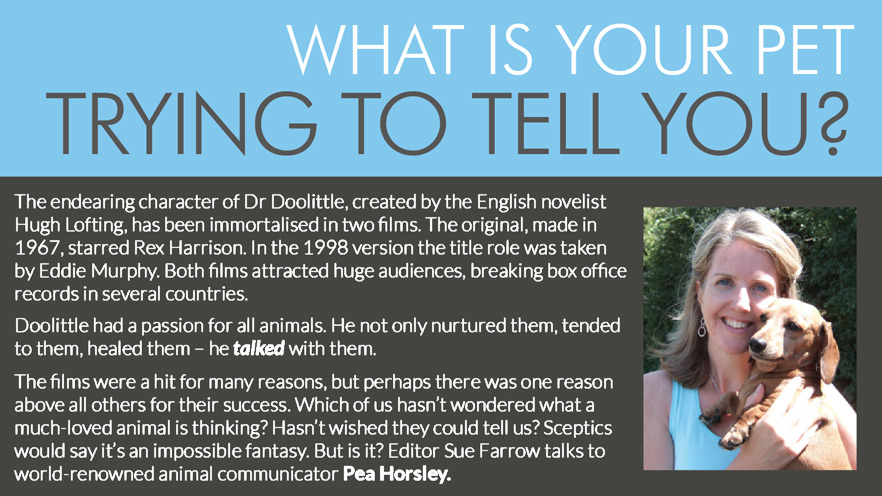
Pea, you spent many years in the down-to-earth role of a stage manager. You’re now one of the world’s most respected animal communicators. What brought about such a radical change of direction?
In a nutshell – Morgan. I adopted my first dog, a pure-bred mutt of questionable beagle heritage, in 2004. Little did I know then what a huge impact he’d have on my life.
At the time I was working in London’s West End on a play called The Old Masters. Morgan came into my life and after the initial settling-in period all rescued animals need, I became aware that his sadness was not going away. I thought it was something I’d been doing wrong, having been a cat person all my life.
When the Mayhew Animal Home, where I’d adopted him from, emailed an invitation to an animal communication workshop, I knew I had to go. I thought it was the latest way of reading an animal’s body language.
Twenty people sat in a circle as the teacher told us how we could all learn to talk to animals. Nineteen were crying as they listened to the stories, and then there was me. I was full of disbelief and sat with my arms and legs crossed, and probably a scowl on my face. I didn’t believe a word of it.
Despite challenging the teacher in the break, I decided to stay, and in the afternoon we were partnered up and asked to communicate with each other’s animal just from their photo. I thought it was crazy. My internal dialogue was along the lines of, ‘You’re just a rabbit. Not even a real rabbit, you’re just a photo of a rabbit and you can’t hear me, can you?!’ Then in my mind I heard the reply, ‘Who the hell do you think is listening to you?’
Silently I asked the given questions and received adequate but imperfect answers, which I dismissed as my imagination. What blew my mind was when my partner, who was communicating with my cat Texas, described my hallway, the colour of my sofa and Texas’ favourite place to sit in the garden. It was like she’d been given a private tour.
This experience made me realise that what I’d thought was the truth in fact wasn’t. The idea of being able to communicate with animals was changing my perception of reality, the way I viewed animals.
I needed to know more so I attended another workshop. It was there that I had my ‘lightbulb moment’ and I realised without any uncertainty that I was meant to be an animal communicator and that everything I’d done up to that point had been in preparation for the animal work I was about to begin.

While still slightly sceptical about human-animal communication, you asked a fly which had settled on your arm to perform a manoeuvre, which it did, three times. Were you shocked?
No, I guess I wasn’t really. I’d been communicating with animals for some months by then so I understood there was a degree to which I could connect telepathically. However, being a practical and very grounded person, I was constantly seeking verification that I was really communicating with animals, that it really was possible.
That day with the fly I’d just finished communicating with a cat. I was sitting by my garden table when a fly came and landed on my left hand. The thought struck me – I wonder if he can hear me? So telepathically I said to the fly, ‘If you can understand me please fly round this table’s parasol and come back to my hand’. Immediately, the insect rose from my hand and flew anti-clockwise round the parasol and landed straight back on my left hand. ‘That’s pretty impressive,’ I told the fly. ‘Can you do it again?’ It did. I asked a third time, adding, ‘and I will never question again that animal communication is possible.’ Quick as a flash, he was off, up into the air, round the parasol anti-clockwise then came to land on my left hand. ‘Incredible! Thank you!’ I said, full of a new sense of appreciation for flies, and at that he flew out of my garden.
On your website you use the phrase ‘remembering this subtle language’ of animal-human communication. Does that imply that we all once knew this language, and perhaps still retain it in some deeply-buried part of ourselves?
Yes, I believe animal communication is a natural skill we all once possessed. It’s an innate ability and dates back to ancient times when our ancestors used to relate to other animals this way. It’s not something supernatural, it’s super-natural, as in very natural. Animal communication is the most natural way of co-existing and is crucial for our current time when there is so much disconnection and a virus of separation sickness is spreading so fast through our species.
People are engaging increasingly with animal communication because they are keen to feel a deep level of connection. We’ve been seeking connection in all the wrong ways, through external sources and technology, but the real connection comes from deep within ourselves. When we engage with animal communication, we understand that all life is connected.
Whether we choose to act or to linger in apathy will perhaps determine whether we and other species continue to survive. At this time, animal communication is the fastest way of waking people up and may be the only way we can protect our planet, and ultimately ourselves.

A number of vets refer animals to you. Is this when conventional diagnosis is proving difficult and the animal might be able to shed light on its own condition?
Vets sometimes refer people to me because they feel there is something deeper going on than a physical condition or an emotional example of distress, and are aware that a consultation where the guardian hears from their animal can unlock and resolve the deeper concern.
Sometimes guardians need help finding out what’s wrong with an animal. In my new book there’s a story about Peter, a rabbit, who had had his teeth checked and treated by his vet, but shortly afterwards stopped eating. His health was going downhill fast.
I communicated with him and Peter was able to explain through a combination of picture images and thought-forms that the vet had missed a spike hidden at the back of his mouth. The guardian returned to the vet, who was open and thankful for this information once he discovered it was the cause of the problem. He removed the spike, Peter started eating again and went on to live for another two years.
Have you encountered vets or veterinary nurses who are able to communicate telepathically with their patients? Have any approached you for help in learning animal communication techniques?
Veterinary nurses attend my workshops quite regularly and a handful of vets have attended too. I know of a couple of vets who are able to communicate with animals and they explain how useful it is, because explaining procedures to animals helps dispel their fear and helps them relax while they are receiving treatment. Of course, I think there are some vets who are already communicating with animals, but they may or may not be consciously aware that this is what they are doing.
Many dogs (and probably other animals) are vet-phobic, or at least uneasy about a visit to the surgery. My own beloved Jack Russell is among them! How do you approach helping an animal to overcome that fear?
I think it’s important to make the visit as positive as possible. Be the vibration you wish your animal to be. If you are calm, it gives them a frequency of energy to log on to, so they can move away from their own anxiety or fear, and into calmness. Become aware of your own thoughts and anxieties and how these filter straight to your animal, who is super sensitive to your energy.
Prepare your animal in advance. Picture what will happen, give them a sense of how long they will be there, if they are coming straight home or staying for an x-ray or overnight. Be as clear as you can on what to expect by expressing it through short positive sentences and picture images that you can create in your mind. Just set the intention of these thoughts and pictures landing in their awareness, and trust they are receiving them.
Aside from your initial request to the fly, do you communicate with species other than mammals? If so, are reptiles, birds, fish and insects equally receptive to the contact?
I’ve communicated with snakes, geckos, spiders, tortoises (domestic and large Aldabras), cows, sheep, goldfish, ducks, chickens and so many different species of birds and insects that I’ve lost count. I have also communicated with humpback whales in Australia, fur seals in New Zealand and lions and elephants in Kenya. They are all receptive to contact. Some more than others, depending upon how busy they are – bees are very busy creatures – or whether they are intrigued to have this experience of interspecies communication.
Human-animals are so busy, with hundreds of thoughts dashing through their minds, that many animals never expect us to find the stillness needed to communicate with them. Often animals see us as the suffering species. We are the ones ‘chasing our tail’ and obsessing about our bank balance or status in society. Other species are far more balanced and connected than humans.
Has there ever been an animal you couldn’t reach telepathically?
There are a couple every year, not species specific, just individuals. Sometimes I’ve felt it was the wrong time for the guardian, or I have been the wrong person. There’s normally a good reason and it’s clear pretty quickly that it’s not going to happen. I usually suggest they leave it a while and then consider contacting another professional animal communicator. I always trust the animal because they know their guardian better than anyone and there will be a reason behind it.
Whenever I’m unable to make a connection, the guardian will receive a full refund. I feel it’s important that people can recognise someone who is reputable and that’s why I offer a no-quibble guarantee.

Besides helping individual animals and their guardians by communicating with the animal and delivering their message, you run many workshops teaching animal communication. Do you believe that anyone can learn to be an animal telepath?
We all have the potential to communicate with animals telepathically. It’s in our makeup. We are naturally telepathic. However, we’re human, so we like to get our own way and sometimes the ego (fear/desire) can scupper our experience. When people who attend my workshops relax and go with the flow, they find they begin to receive communication from the animals – accurate details that can be verified.
But there is that ego, the negative voice, the social conditioning, the belief system handed down by parents, teachers and colleagues, which might keep individuals stuck in old thought patterns that it is not possible, or at least ‘not possible for me’. I have found this year, more than ever, that students want to have amazing 100-per-cent-accurate communications with animals instantly. I guess it’s the get-rich-quick/instant-celebrity culture we live in that creates this approach to instant gratification.
I do witness wonderful examples of animal communication from students who are often amazed that they can receive something so accurately from an animal they’ve never met. This is when the hard work really begins.
I explain to students that this is a remembering process and, like learning any new language, takes time and practice. As much as I’d love to be fluent in Italian instantly, I’d have to practise regularly to be able to hold a conversation, and it’s the same with learning the language of animals.
I follow the ‘Three P’s’ given to me early on in my career: Practice. Purpose. Patience.

